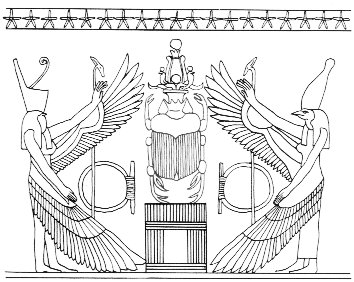3. A mauga glyph normally has a rhomb-like bulge, not seen in the Egyptian nehet glyph:
The sun is not formed like a rhomb. Instead the rhomb probably is a picture of the earth, which has 4 sides and 4 corners. It is not hard to imagine the proper 'map' to be like a rhomb rather than a square - right and left are the equinoxes (east and west), at top and bottom are the solstices (north and south):
This Egyptian picture (from Wilkinson) shows how the 4 wings delineate a rhomb. In the middle at bottom is a door in the east through which sun (the beetle) moves up. At left is north (shown by the snake-like head ornament in the crown of Lower Egypt) and at right is south (shown by the crown of Upper Egypt). Only by imagining looking up at the sky, lying down with feet towards east and head towards west, does the picture agree with the cardinal directions. In mauga glyphs the rhomb is never drawn as if a separate unit. Therefore mauga and earth probably are the same. The translation of the picture becomes 'the shadow of earth'. It cannot mean the shadow which earth casts upon the stellar person in question. Instead it ought to mean the shadow in which earth is lying. The stellar persons do not stop shining, it is an illusion because we are in the shadow. |

